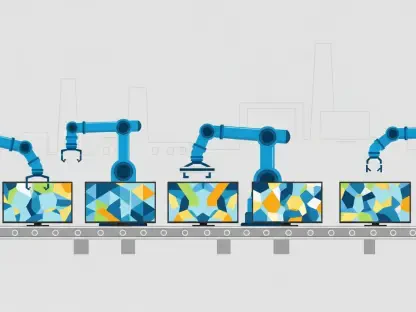Hewlett Packard Enterprise (HPE) is leading a transformative wave in enterprise technology by harnessing the power of artificial intelligence to create self-driving networks, redefining how IT infrastructure operates in modern businesses. Through its innovative Mist Agentic AI-Native Platform and the strategic integration of Juniper Networks’ expertise, HPE is making a fundamental shift from reactive troubleshooting to proactive, predictive management. These autonomous networks are not merely an upgrade to existing systems; they represent a new era of efficiency. Imagine a corporate environment where network disruptions during critical operations, such as global video conferences, are anticipated and resolved without any human intervention. This leap forward addresses long-standing challenges of complexity, cost, and downtime, offering enterprises a seamless way to maintain productivity. As digital transformation accelerates, HPE’s advancements position it as a frontrunner in delivering intelligent, self-sustaining network solutions that promise to shape the future of IT operations across industries.
Harnessing AI for Network Autonomy
The backbone of HPE’s groundbreaking approach to networking lies in the Mist platform, which employs agentic AI to drive true autonomy in enterprise systems. This technology enables networks to self-diagnose and self-heal by leveraging tools like Marvis Minis, which function as digital twins to simulate user experiences across applications such as Microsoft Teams or Zoom. By analyzing vast datasets in real time, these tools predict potential bottlenecks and address them before they impact performance. This predictive capability marks a significant departure from traditional IT practices, where issues are often dealt with only after they disrupt operations. The result is a dramatic reduction in downtime, allowing businesses to maintain productivity even during peak usage periods. HPE’s focus on minimizing human intervention through such intelligent systems is setting a new benchmark for how networks can operate with unprecedented efficiency in demanding environments.
Complementing this innovation is the Marvis AI Assistant, enhanced with conversational AI to streamline interactions for IT teams. This tool allows staff to manage complex network tasks through simple, natural language commands, effectively bridging the gap between technical systems and human operators. Additionally, Marvis Actions automates the resolution of identified issues, achieving remarkable results such as a reported 90% faster incident resolution and an 85% reduction in the need for on-site visits. These advancements translate into tangible benefits for enterprises, slashing operational overhead and freeing up valuable resources. By reducing the reliance on manual processes, HPE is not only enhancing network reliability but also empowering IT professionals to focus on strategic priorities rather than routine maintenance. This shift underscores the transformative potential of AI in redefining the operational landscape for businesses of all sizes.
Building a Robust Ecosystem Through Strategic Alliances
HPE’s vision for self-driving networks extends beyond standalone technology, encompassing a comprehensive ecosystem bolstered by strategic acquisitions and partnerships. The integration of Juniper Networks’ portfolio has significantly enhanced HPE’s capabilities, while collaboration with NVIDIA, incorporating advanced Blackwell GPUs and GreenLake Intelligence, has paved the way for a hybrid cloud environment. In this setup, AI agents manage critical layers of infrastructure—networking, compute, and storage—with seamless coordination. This holistic approach ensures that enterprises can operate across diverse environments without the friction often associated with disparate systems. By creating a unified platform, HPE addresses the growing need for cohesive solutions that can adapt to the evolving demands of digital-first businesses, positioning itself as a key player in modern IT infrastructure.
Further strengthening this ecosystem is the Marvis AI Assistant for Data Centers, paired with Apstra’s contextual graph database, which continuously validates and optimizes data center networks. This combination delivers impressive outcomes, including a 30% reduction in operational expenditures and a 50% acceleration in service deployment times. Such efficiencies are critical for enterprises managing large-scale, resource-intensive operations where cost and speed are paramount. These integrations reflect HPE’s commitment to not just innovating within networking but also reimagining how interconnected systems can work together to drive business value. The focus on multi-layered infrastructure management ensures that enterprises can scale effortlessly while maintaining high standards of performance and reliability, a crucial factor in today’s competitive landscape.
Dominating the Market with Innovative Edge
In the fiercely competitive arena of enterprise networking, HPE has carved out a formidable position with a 15.9% share in the Wireless Local Area Network (WLAN) market as of the first quarter of this year. The company’s revenue growth stands at an impressive 10.7%, reaching $363.9 million, further boosted by Juniper’s contribution. In stark contrast, a major competitor like Cisco, despite commanding a 39.5% market share, shows slower growth at 4.6% and struggles with fragmented AI adoption. HPE’s recognition as a Leader in Gartner’s latest Magic Quadrant, alongside Juniper, highlights its forward-thinking approach to AI-driven solutions and security. This distinction underscores how HPE’s unified strategy—melding Aruba’s enterprise management with Juniper’s automation—positions it to lead the charge in next-generation networking, outpacing rivals in innovation and market responsiveness.
This competitive edge is not just about numbers but also about the practical impact of HPE’s technology on enterprise operations. The company’s ability to deliver cohesive, AI-native solutions addresses critical gaps in the market, particularly in areas like scalability and integration, where others fall short. By prioritizing a security-first mindset alongside automation, HPE ensures that businesses can trust their networks to handle sensitive data and complex workloads without compromising safety. This focus on comprehensive solutions is evident in how HPE’s offerings are tailored to meet the nuanced needs of modern enterprises, from small businesses to global corporations. As the demand for intelligent infrastructure grows, HPE’s market leadership signals its readiness to define the standards for future networking technologies, making it a pivotal force in the industry.
Transforming Enterprise Investments with AI Solutions
HPE’s advancements in self-driving networks are reshaping the way enterprises allocate resources for IT infrastructure, moving away from labor-intensive maintenance to strategic innovation. By tackling persistent challenges such as high operational costs and scalability issues, these AI-driven systems enable businesses to redirect budgets toward growth initiatives rather than routine fixes. Projections indicate that by 2028, around 35% of enterprises will adopt AI for network operations, a trend that HPE is already capitalizing on with tools like GreenLake Intelligence. Real-world impacts, such as a university system reporting a 90% reduction in network-related service requests, demonstrate the tangible benefits of these solutions. This shift not only enhances operational efficiency but also positions HPE as a trusted partner for companies navigating the complexities of digital transformation.
From an investment perspective, HPE’s trajectory presents a compelling opportunity as the appetite for AI-native infrastructure surges. The company’s robust financial performance, coupled with measurable returns on investment through its innovative platforms, makes it an attractive prospect for stakeholders looking to capitalize on emerging tech trends. Beyond immediate gains, HPE’s solutions address long-term enterprise needs by ensuring compliance with stringent standards like SOC 2 and FedRAMP, further solidifying trust in its offerings. This alignment with regulatory and operational demands means that enterprises can confidently invest in AI-driven systems without fear of future obsolescence. As businesses increasingly prioritize autonomy in their networks, HPE’s role in driving this paradigm shift offers a clear path for investors and enterprises alike to achieve sustainable growth and competitiveness in a rapidly evolving market.
Paving the Way for Future IT Excellence
Reflecting on HPE’s journey, it’s evident that the company has reshaped the enterprise networking landscape by introducing self-driving networks through the Mist Agentic AI-Native Platform. Strategic integrations with Juniper Networks and partnerships with NVIDIA have fortified a hybrid ecosystem that delivers unmatched efficiency, slashing costs and deployment times for businesses worldwide. HPE’s market dominance, underscored by significant revenue growth and leadership recognition, has outmaneuvered competitors and set new industry standards. Looking ahead, enterprises should consider prioritizing investments in AI-native solutions to stay competitive, leveraging HPE’s proven frameworks to streamline operations. Additionally, exploring how these autonomous systems can integrate with broader digital strategies will be key to unlocking further innovation. As the tech horizon continues to evolve, HPE’s pioneering efforts provide a blueprint for building resilient, intelligent infrastructure that meets tomorrow’s challenges head-on.









